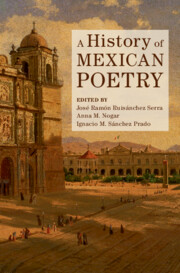Book contents
- A History of Mexican Poetry
- A History of Mexican Poetry
- Copyright page
- Contents
- Figures
- Contributors
- Introduction
- Chapter 1 The Practice of Epic and Lyric Writing in Colonial Mexico
- Chapter 2 La lírica del Fénix: Sor Juana’s Poetic Legacy
- Chapter 3 The Sound of the Word: Music and Social Transgression in Lyric Poetry from the Colonia Onward
- Chapter 4 We, the Romantics
- Chapter 5 Sentimental Sociabilities: The Young Romantics and Their Long-Lived Widows
- Chapter 6 Modernismo’s Strategic Occidentalism: Notes on Manuel Gutiérrez Nájera, Amado Nervo, and José Juan Tablada
- Chapter 7 The Crepusculars: Criollo Modernism and the Invention of the Literary Province
- Chapter 8 Poesía en voz alta: A Trajectory of Poetry and Performance in México
- Chapter 9 The Great Synthesis of the Critical Poets: The Rise of Octavio Paz
- Chapter 10 Octavio Paz and the Institutions of Poetry
- Chapter 11 The Form That Contains Multitudes: The Mexican Long Poem (1924–2020)
- Chapter 12 Radical Freedoms: Neobaroque, Postpoetry
- Chapter 13 The Age of Anthology
- Chapter 14 Twentieth-Century Mexican Poetry: The Popular and the Political
- Chapter 15 Poetry in Indigenous Languages: From the Sixteenth to the Twenty-First Centuries
- Chapter 16 Chicanx Poetry: The Living Lyric
- Chapter 17 Racimos: Dissonances in Mexican Poetry of Today
- Index
- References
Chapter 5 - Sentimental Sociabilities: The Young Romantics and Their Long-Lived Widows
Published online by Cambridge University Press: 21 March 2024
- A History of Mexican Poetry
- A History of Mexican Poetry
- Copyright page
- Contents
- Figures
- Contributors
- Introduction
- Chapter 1 The Practice of Epic and Lyric Writing in Colonial Mexico
- Chapter 2 La lírica del Fénix: Sor Juana’s Poetic Legacy
- Chapter 3 The Sound of the Word: Music and Social Transgression in Lyric Poetry from the Colonia Onward
- Chapter 4 We, the Romantics
- Chapter 5 Sentimental Sociabilities: The Young Romantics and Their Long-Lived Widows
- Chapter 6 Modernismo’s Strategic Occidentalism: Notes on Manuel Gutiérrez Nájera, Amado Nervo, and José Juan Tablada
- Chapter 7 The Crepusculars: Criollo Modernism and the Invention of the Literary Province
- Chapter 8 Poesía en voz alta: A Trajectory of Poetry and Performance in México
- Chapter 9 The Great Synthesis of the Critical Poets: The Rise of Octavio Paz
- Chapter 10 Octavio Paz and the Institutions of Poetry
- Chapter 11 The Form That Contains Multitudes: The Mexican Long Poem (1924–2020)
- Chapter 12 Radical Freedoms: Neobaroque, Postpoetry
- Chapter 13 The Age of Anthology
- Chapter 14 Twentieth-Century Mexican Poetry: The Popular and the Political
- Chapter 15 Poetry in Indigenous Languages: From the Sixteenth to the Twenty-First Centuries
- Chapter 16 Chicanx Poetry: The Living Lyric
- Chapter 17 Racimos: Dissonances in Mexican Poetry of Today
- Index
- References
Summary
This chapter proposes that the most enduring contribution of the ill-fated second generation of Romanticism – whose members included the suicidal Manuel Acuña and syphilitic Manuel M. Flores, to name but two – was not that they exhibited traits associated with European Romanticism. Rather, this chapter posits that they gave rise to a longue durée Romantic sensibility that lasted well into the twentieth century. Furthermore, we here argue that this important legacy belongs to mostly female authors, starting with Laura Méndez de Cuenca and María Enriqueta, who begin their successful careers in the nineteenth century. The work of these and other female authors, widely read by their contemporaries but then omitted from scholarly attention, demands examination, in particular as scholarly interest in their work intensifies.
Keywords
- Type
- Chapter
- Information
- A History of Mexican Poetry , pp. 96 - 111Publisher: Cambridge University PressPrint publication year: 2024



